Introduction to Small Portable Air Conditioners for Camping
When it comes to enjoying the great outdoors, finding the right cooling solution is essential, especially during hot summer months. The smallest portable air conditioner for camping can provide the comfort you need while being lightweight and easy to transport. In this blog, we’ll explore the top options available, debunk common myths, and discuss eco-friendly alternatives that make your camping experience more enjoyable.
Camping is a fantastic way to escape the hustle and bustle of everyday life, but it often comes with the challenge of staying cool in hot weather. Small portable air conditioners have emerged as a popular solution for campers looking to maintain a comfortable temperature in their tents or RVs. These compact units are designed to be lightweight and energy-efficient, making them an ideal choice for outdoor enthusiasts who prioritize comfort without sacrificing mobility.
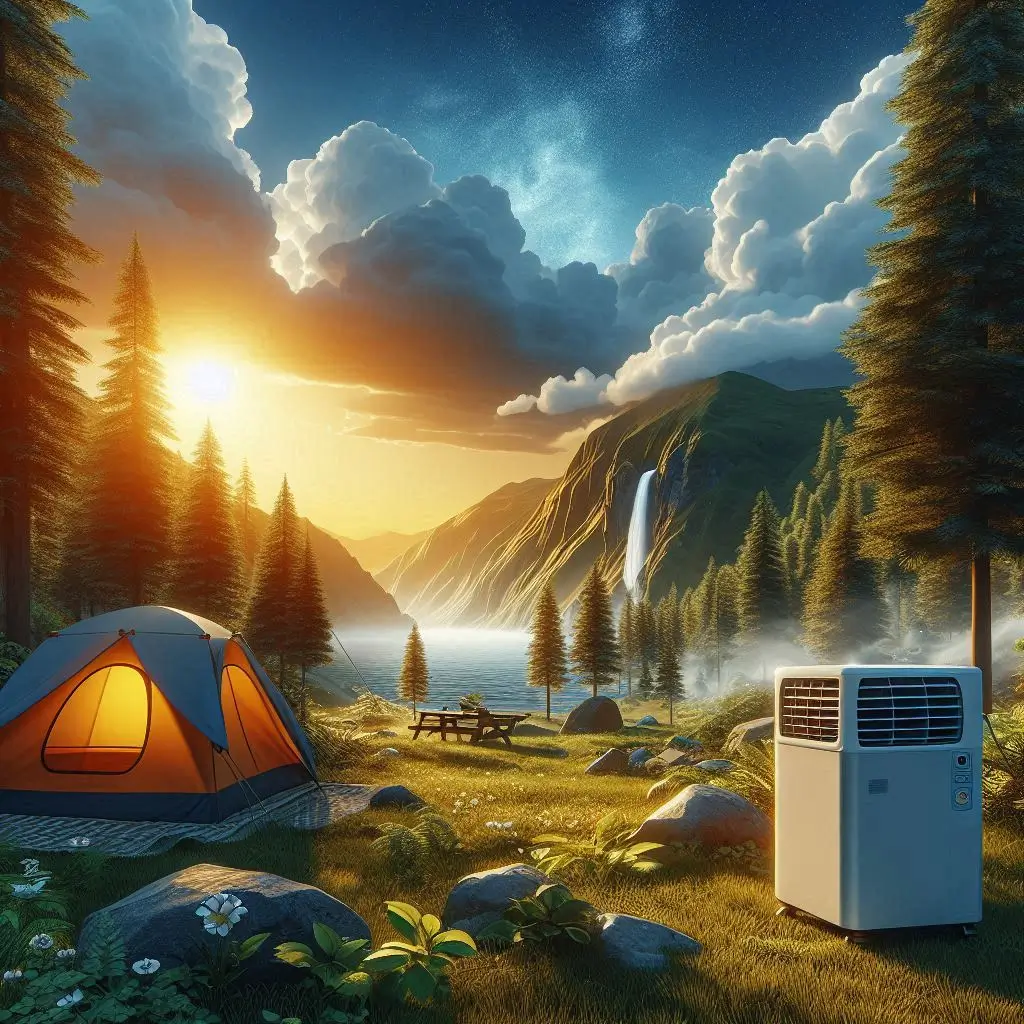
Benefits of Using Portable Air Conditioners While Camping
-
Comfortable Sleeping Environment: One of the primary benefits of a portable air conditioner is the ability to create a comfortable sleeping environment. Hot and humid nights can lead to restless sleep, but a small air conditioner helps regulate the temperature, ensuring a good night’s rest.
-
Energy Efficiency: Many modern portable air conditioners are designed with energy efficiency in mind. They consume less power than traditional units, making them perfect for use with solar panels or generators often used during camping trips.
-
Easy Setup and Portability: Small portable air conditioners are designed for easy setup and mobility. Most models are lightweight and come with handles or wheels, allowing campers to move them effortlessly between locations.
-
Versatile Usage: These air conditioners can be used in various camping settings, including tents, RVs, or cabins. Their versatility means they can adapt to different environments and needs, providing comfort wherever you are.
-
Improved Air Quality: Portable air conditioners often come equipped with air filters that can help improve air quality by removing dust, allergens, and pollutants. This is especially beneficial for individuals with allergies or respiratory issues.
Key Features to Consider
When selecting the smallest portable air conditioner for camping, it’s essential to consider several key features to ensure you choose a unit that meets your needs:
-
Cooling Capacity: The cooling capacity is measured in British Thermal Units (BTUs). For camping, a unit with 5,000 to 8,000 BTUs is generally sufficient for tents or small RVs, ensuring efficient cooling without excessive energy consumption.
-
Size and Weight: Look for compact models that are lightweight and easy to transport. A portable air conditioner designed specifically for camping will typically weigh between 25 to 40 pounds, making it manageable to carry.
-
Power Source: Consider how you will power your portable air conditioner. Many models offer dual power options, allowing them to run on AC power or battery, which is ideal for off-grid camping situations.
-
Noise Level: Noise can be a significant factor when camping. Look for units with low decibel ratings (around 50 dB) to minimize noise disruption during your relaxation and sleep time.
-
Ease of Use: Opt for models with user-friendly controls, remote operation, and simple installation processes. This ensures that you can set up your air conditioner quickly and focus on enjoying your camping experience.
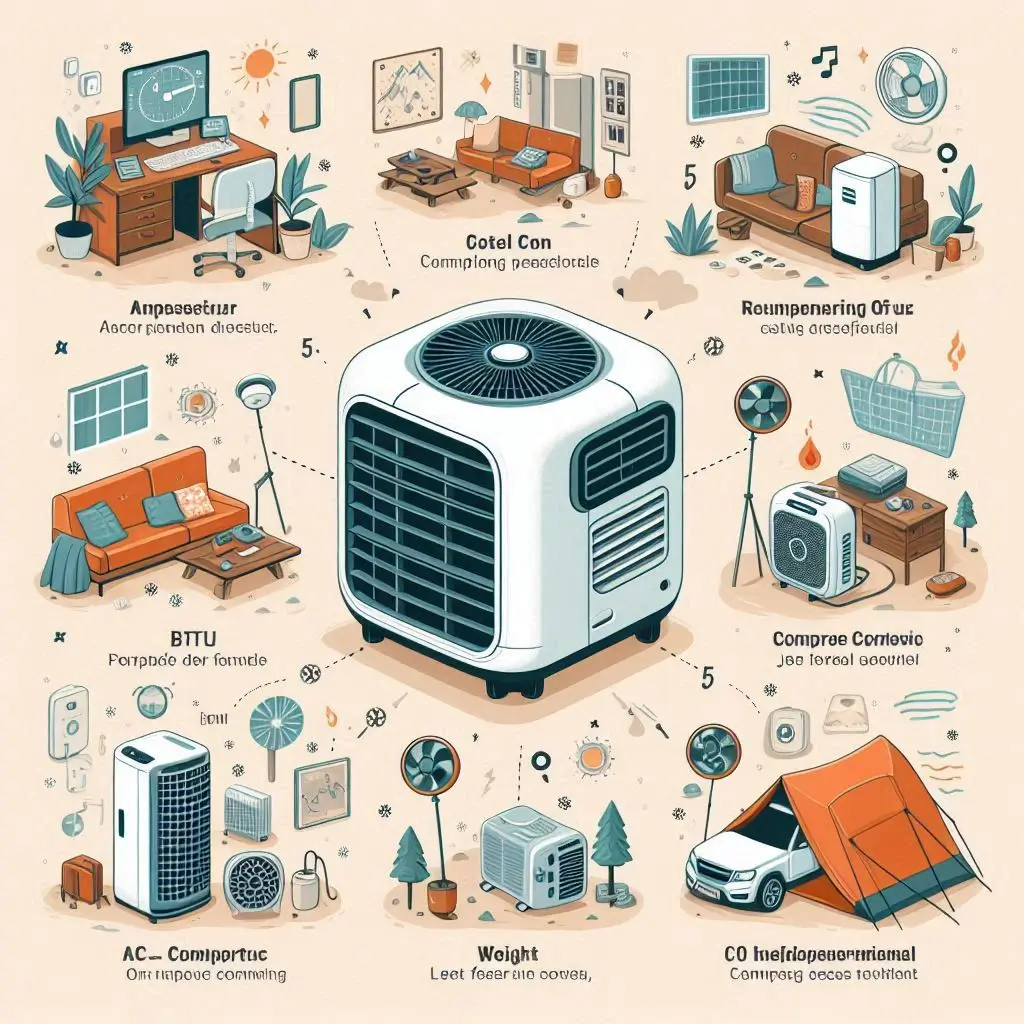
Top Smallest Portable Air Conditioners for Camping
Product 1: Zero Breeze Mark 2
Specifications
- Cooling Capacity: 2,300 BTU
- Weight: 16.5 lbs
- Power Source: Battery-powered with an optional AC adapter
- Run Time: Up to 5 hours on battery
- Dimensions: 11.5 x 9.5 x 19 inches
- Noise Level: 50 dB
The Zero Breeze Mark 2 is an innovative solution for campers seeking efficient cooling without the bulk. Its compact design makes it one of the lightest portable air conditioners available, perfect for camping trips where weight and space are limited.
Pros and Cons
Pros:
- Lightweight and highly portable.
- Runs on batteries, ideal for off-grid camping.
- Includes a built-in air pump for inflatable items.
Cons:
- Limited cooling capacity compared to larger units.
- Battery life may not be sufficient for extended use.
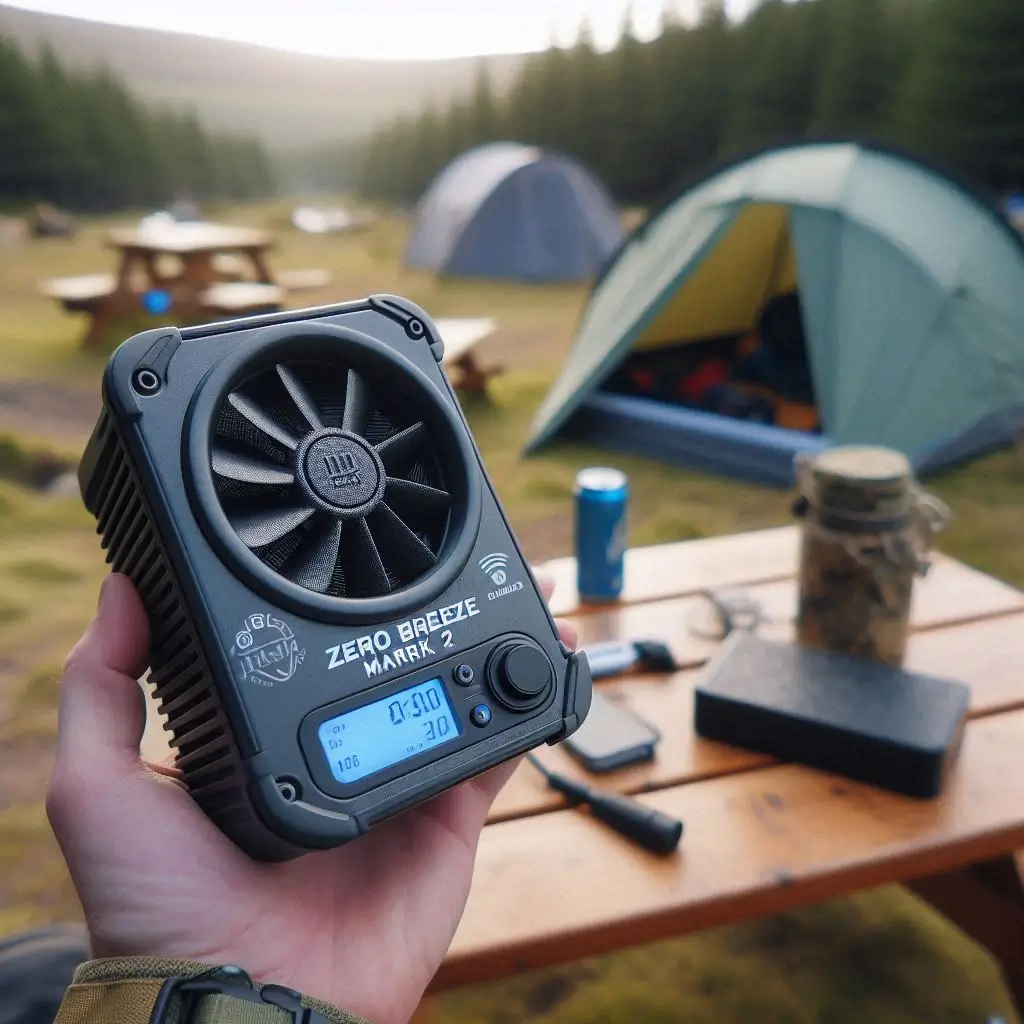
Product 2: BLACK + DECKER BPACT08WT Portable Air Conditioner
Specifications
- Cooling Capacity: 8,000 BTU
- Weight: 70 lbs
- Power Source: AC powered
- Run Time: Continuous with proper power supply
- Dimensions: 17.5 x 11.5 x 26 inches
- Noise Level: 55 dB
The BLACK + DECKER BPACT08WT is a versatile portable air conditioner that balances power and portability. Although slightly heavier than others, its efficient cooling makes it suitable for larger tents or RVs.
Pros and Cons
Pros:
- High cooling capacity for larger spaces.
- Easy to set up with a simple window installation kit.
- Multiple cooling and fan speeds for customized comfort.
Cons:
- Heavier than some competitors, making it less portable.
- Requires a power source, limiting its use in remote areas.
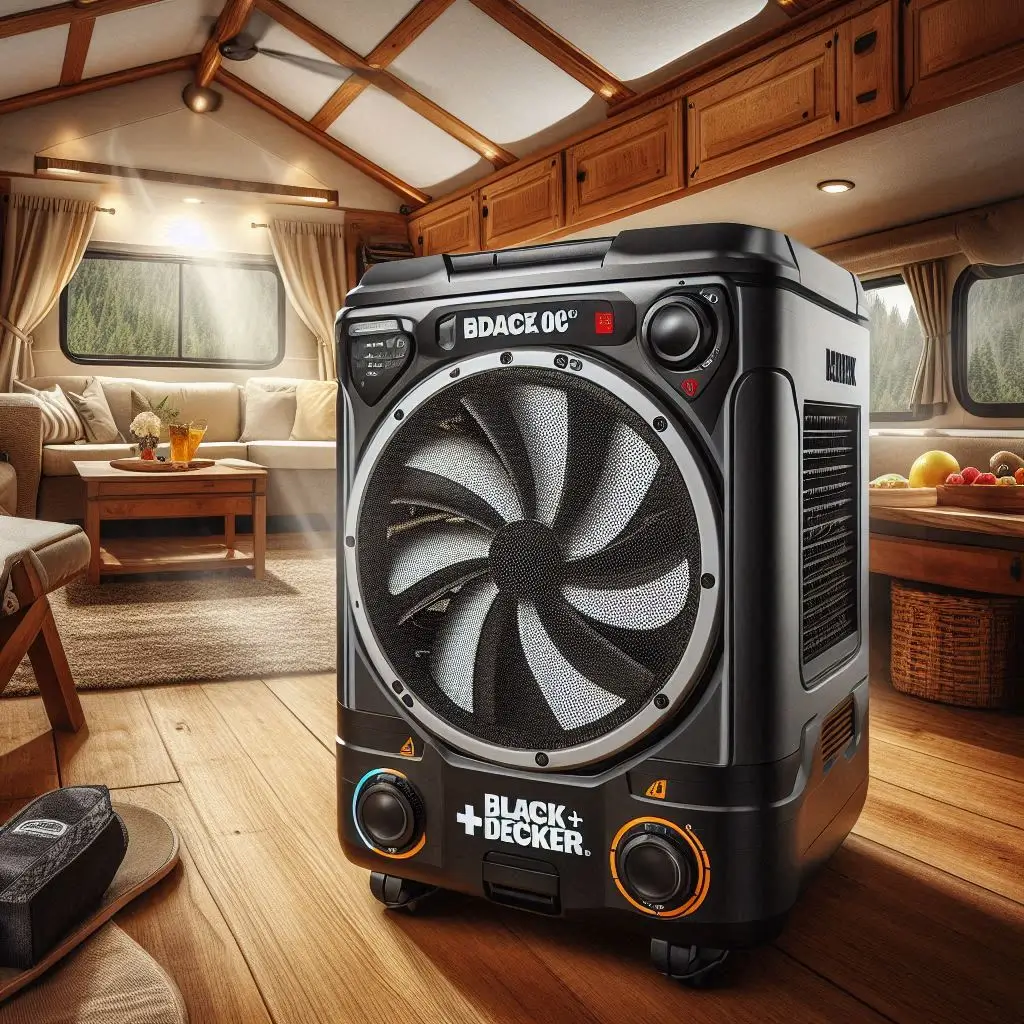
Product 3: Evapolar evaCHILL Portable Air Cooler
Specifications
- Cooling Capacity: Not specified (evaporative cooling)
- Weight: 2.2 lbs
- Power Source: USB powered
- Run Time: Continuous when plugged in
- Dimensions: 7.7 x 7.7 x 7.9 inches
- Noise Level: 30 dB
The Evapolar evaCHILL is a unique portable air cooler that uses evaporative cooling technology. It’s incredibly lightweight and designed for personal use, making it perfect for individual campers looking for localized cooling.
Pros and Cons
Pros:
- Extremely lightweight and compact.
- Low power consumption, can run on portable power banks.
- Quiet operation, ideal for nighttime use.
Cons:
- Limited cooling area; best for individual use rather than whole tents.
- Relies on ambient humidity for effectiveness.
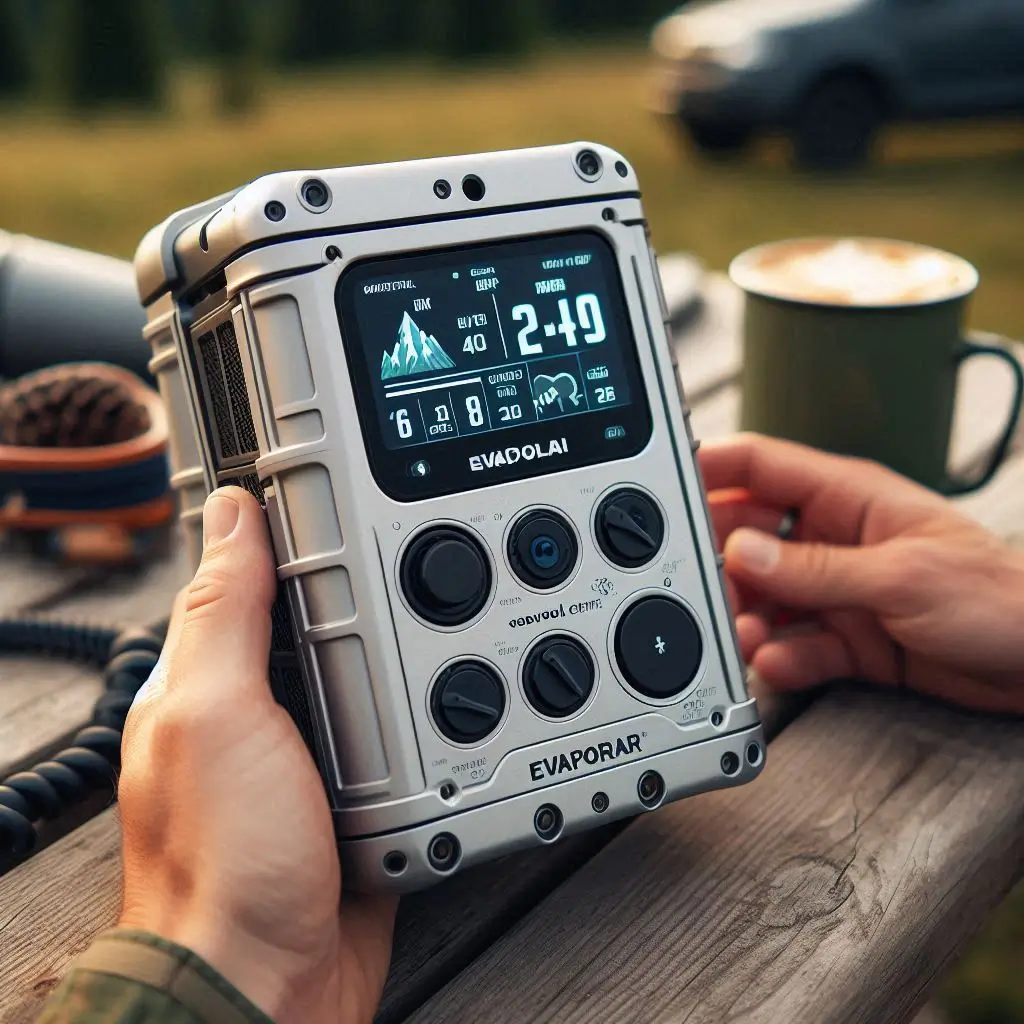
How to Choose the Right Portable Air Conditioner for Your Camping Needs
Choosing the right portable air conditioner for camping is crucial for ensuring a comfortable and enjoyable experience outdoors. With various options available, understanding the key factors to consider will help you make an informed decision. Here are essential aspects to keep in mind when selecting a portable air conditioner for your camping needs.
Size and Weight Considerations
When it comes to camping, portability is paramount. The size and weight of your portable air conditioner directly impact how easily you can transport and set it up.
-
Weight: Look for models that weigh between 25 to 40 pounds, as these are generally manageable for most campers. Lightweight units are easier to carry, especially if you’re hiking to your campsite.
-
Dimensions: Consider the available space in your tent or RV. Compact models are ideal for smaller setups, while slightly larger units may be suitable for larger tents or RVs. Ensure that the unit fits comfortably without taking up too much living space.
-
Storage: Think about how you will store the air conditioner when not in use. Some models come with collapsible designs or built-in handles that make them easier to stow away.

Power Source Options
Understanding the power source options for portable air conditioners is essential, especially for camping in remote locations.
-
AC Power: Many portable air conditioners are designed to plug into standard wall outlets. If you’re camping in areas with access to electricity (such as campgrounds with hookups), this is a convenient option.
-
Battery-Powered: Some models offer battery-powered operation, which is ideal for off-grid camping. These units allow you to use the air conditioner without worrying about finding a power source. However, be mindful of the battery life and whether you’ll need to recharge it during your trip.
-
Solar Power: If you’re an eco-conscious camper, consider units that can be powered by solar panels. These air conditioners are great for sustainable camping, allowing you to enjoy cool air while minimizing your carbon footprint.
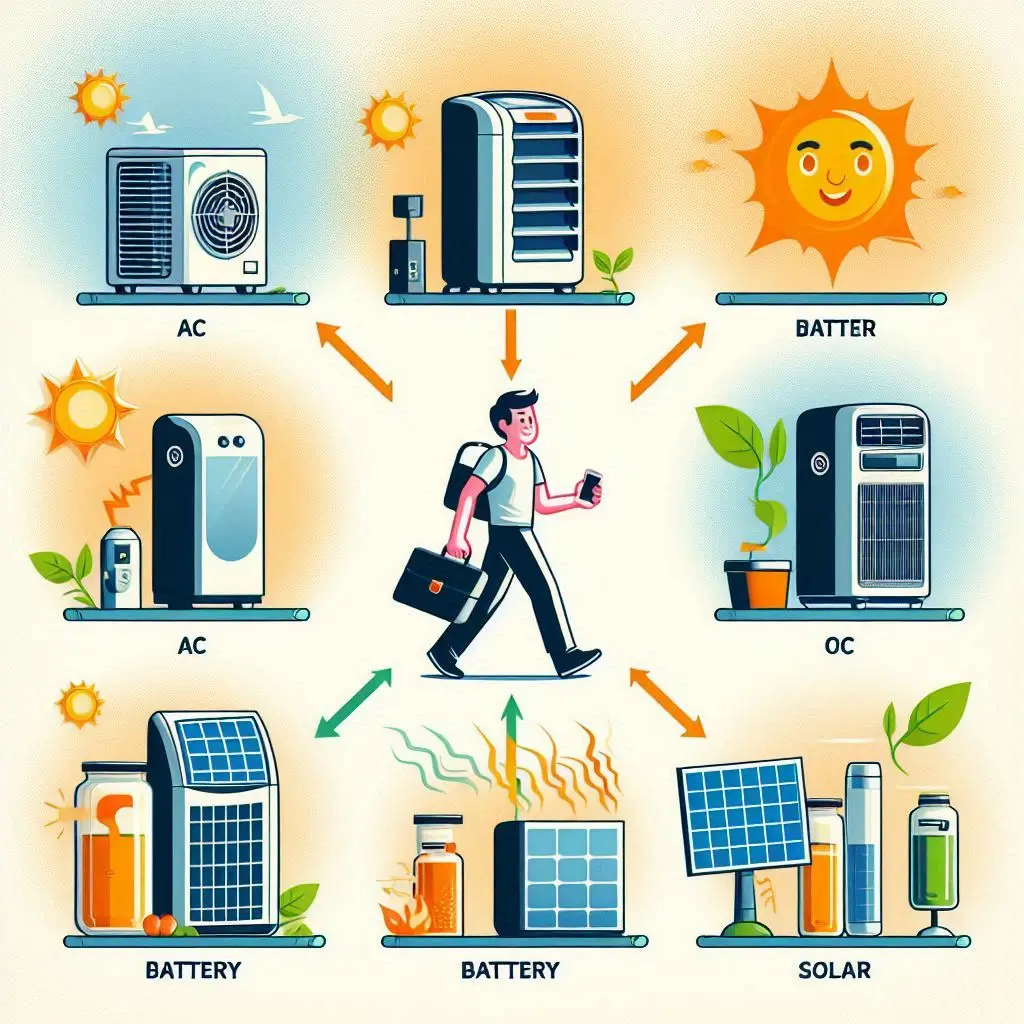
Cooling Capacity and Efficiency
The cooling capacity and efficiency of a portable air conditioner are critical factors that determine how well it can maintain a comfortable temperature in your camping environment.
-
Cooling Capacity: Measured in British Thermal Units (BTUs), the cooling capacity indicates how much heat the unit can remove from the air. For camping, a unit with a capacity of 5,000 to 8,000 BTUs is generally suitable for tents and small RVs. Consider the size of your tent or RV when choosing a model.
-
Energy Efficiency: Look for portable air conditioners with high Energy Efficiency Ratio (EER) ratings. Higher EER ratings indicate that the unit uses less energy to produce the same cooling effect, helping you save on energy costs and extend battery life.
-
Multi-Functional Features: Some portable air conditioners offer additional features like fan modes and dehumidification settings. These functionalities can enhance comfort and improve air quality, making your camping experience more enjoyable.

Tips for Setting Up Your Portable Air Conditioner While Camping
Setting up your portable air conditioner correctly is essential to ensure optimal cooling and comfort during your camping trips. By following these tips, you can maximize the efficiency of your air conditioner and create a comfortable environment in your campsite.
Ideal Location for Placement
-
Close to a Power Source: If your portable air conditioner requires an AC power supply, position it near an outlet or use an extension cord to connect it. This will reduce the risk of tripping over cords and ensure a stable power connection.
-
Ventilation Considerations: Ensure there is adequate ventilation for the unit to function effectively. Place the air conditioner in a location where the exhaust vent can expel hot air outside of your tent or RV. Avoid placing it against walls or other obstructions that could impede airflow.
-
Shade and Protection: Whenever possible, set up the air conditioner in a shaded area to enhance its cooling efficiency. Direct sunlight can increase the workload on the unit, reducing its effectiveness. Additionally, placing the air conditioner on a stable surface will prevent vibrations and noise.
-
Distance from Sleeping Areas: To minimize noise disruption during the night, consider placing the air conditioner away from sleeping areas. This will help create a quieter environment while still providing sufficient cooling.
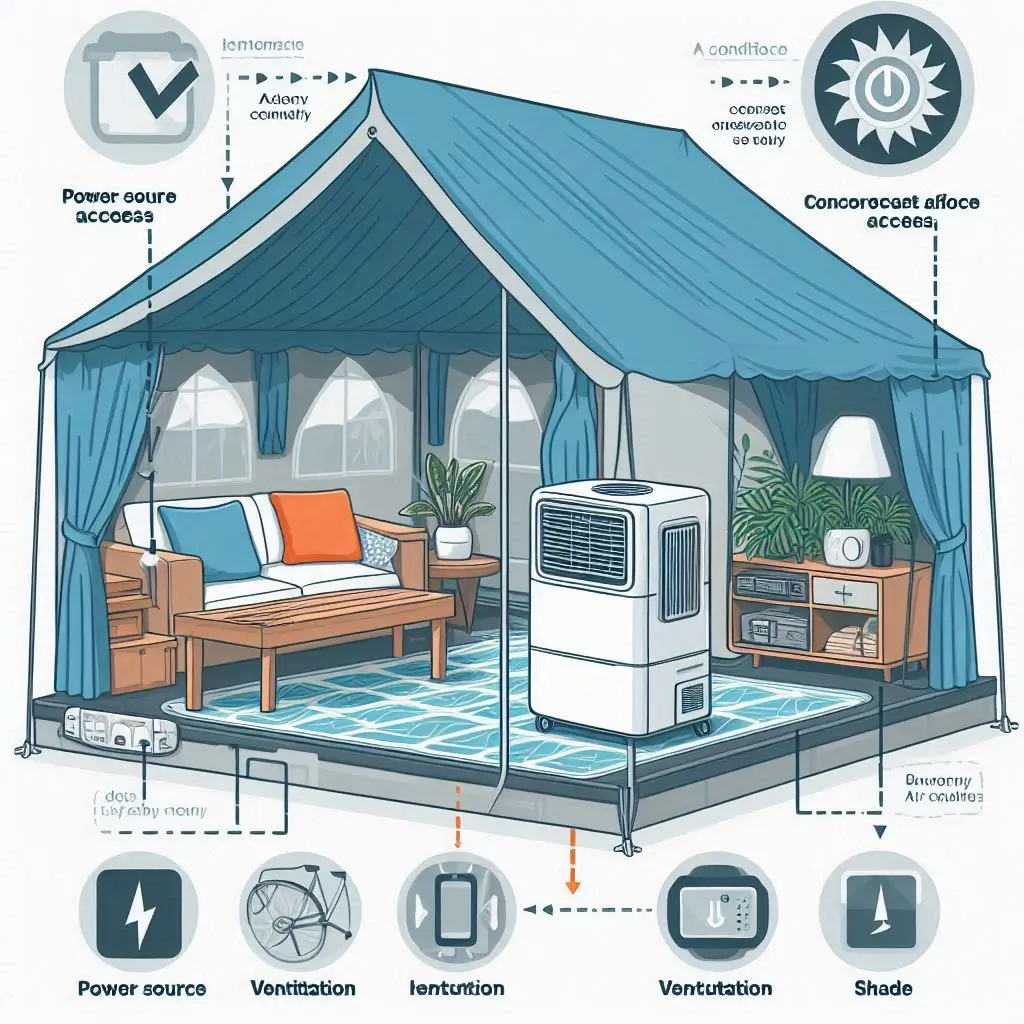
Maintaining a Comfortable Temperature
-
Setting the Right Temperature: Start by setting the air conditioner to a comfortable temperature, typically between 70°F and 75°F (21°C to 24°C). Avoid setting it too low initially, as this can lead to overworking the unit and increased energy consumption.
-
Using Fans: To enhance airflow and distribute cool air more evenly, consider using additional fans. Placing a fan in front of the air conditioner can help circulate the cool air throughout the tent or RV, improving overall comfort.
-
Closing Doors and Windows: To maintain a consistent temperature, keep doors and windows closed while the air conditioner is running. This helps prevent cool air from escaping and hot air from entering, allowing the unit to work more efficiently.
-
Regular Maintenance Checks: Periodically check the air filter and clean it as needed to ensure optimal performance. A clogged filter can reduce airflow and efficiency, making it harder for the unit to maintain a comfortable temperature.
-
Consider External Factors: Be mindful of external temperatures and conditions. If it’s particularly hot outside, you may need to adjust the settings or run the air conditioner for longer periods to maintain a comfortable environment.
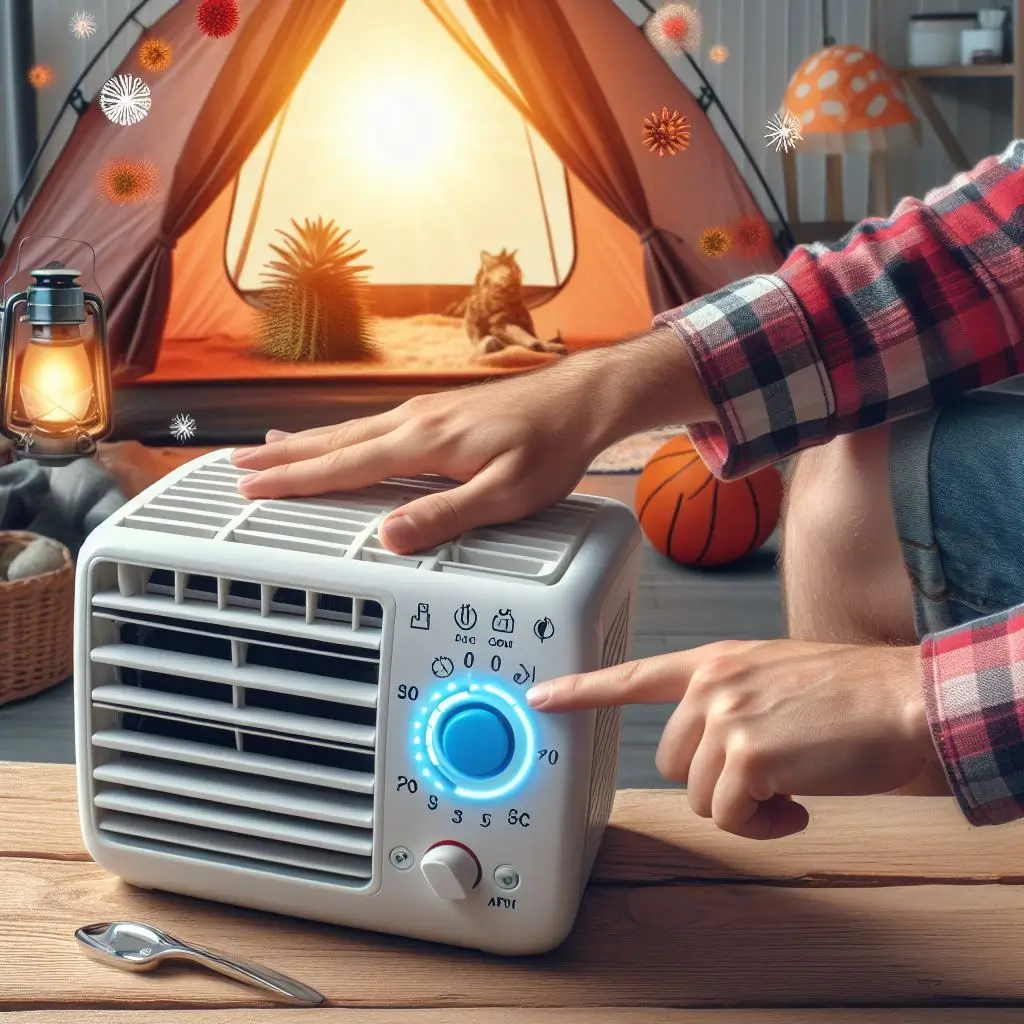
FAQs About Portable Air Conditioners for Camping
1. What is the smallest portable air conditioner suitable for camping?
The smallest portable air conditioner suitable for camping varies by model, but options like the Evapolar evaCHILL, which measures just 7.7 x 7.7 x 7.9 inches and weighs only 2.2 lbs, are excellent choices for campers who prioritize portability. These compact units are designed for personal cooling and can be easily transported in a backpack or camping gear.
Image Prompt: An image showcasing the Evapolar evaCHILL next to standard camping gear, illustrating its compact size and portability.
2. How do I set up my portable air conditioner while camping?
Setting up your portable air conditioner while camping involves a few simple steps:
- Choose the Right Location: Select a shaded area near a power source, ensuring adequate ventilation for the unit.
- Position the Exhaust Vent: Make sure the exhaust vent is directed outside your tent or RV to expel hot air effectively.
- Secure Power Connection: Connect the air conditioner to a reliable power source, using extension cords if necessary.
By following these steps, you can maximize the efficiency of your air conditioner and maintain a comfortable temperature inside your campsite.
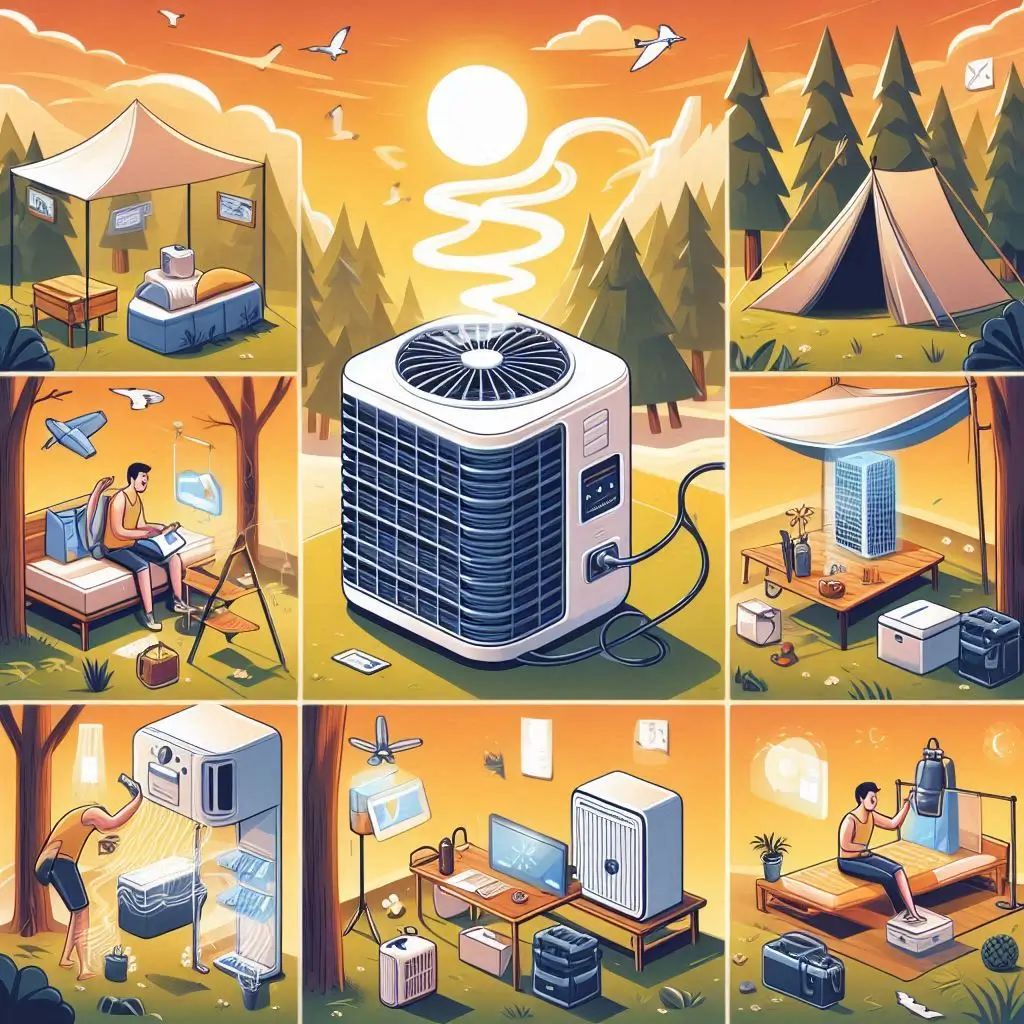
3. How much cooling capacity do I need for camping?
The required cooling capacity for camping depends on the size of your tent or RV. For smaller tents (up to 100 square feet), a portable air conditioner with a capacity of around 5,000 BTUs is usually sufficient. For larger spaces, such as bigger tents or RVs (up to 200 square feet), consider units with 8,000 BTUs or higher. It’s essential to match the BTU rating to the size of the space to ensure effective cooling.
4. Can I run my portable air conditioner on battery power while camping?
Yes, many portable air conditioners can run on battery power, making them ideal for off-grid camping. Look for models specifically designed for battery operation, such as the Zero Breeze Mark 2, which provides up to 5 hours of cooling on a full charge. Ensure to monitor the battery level and have a plan for recharging if you plan on using the unit for extended periods.
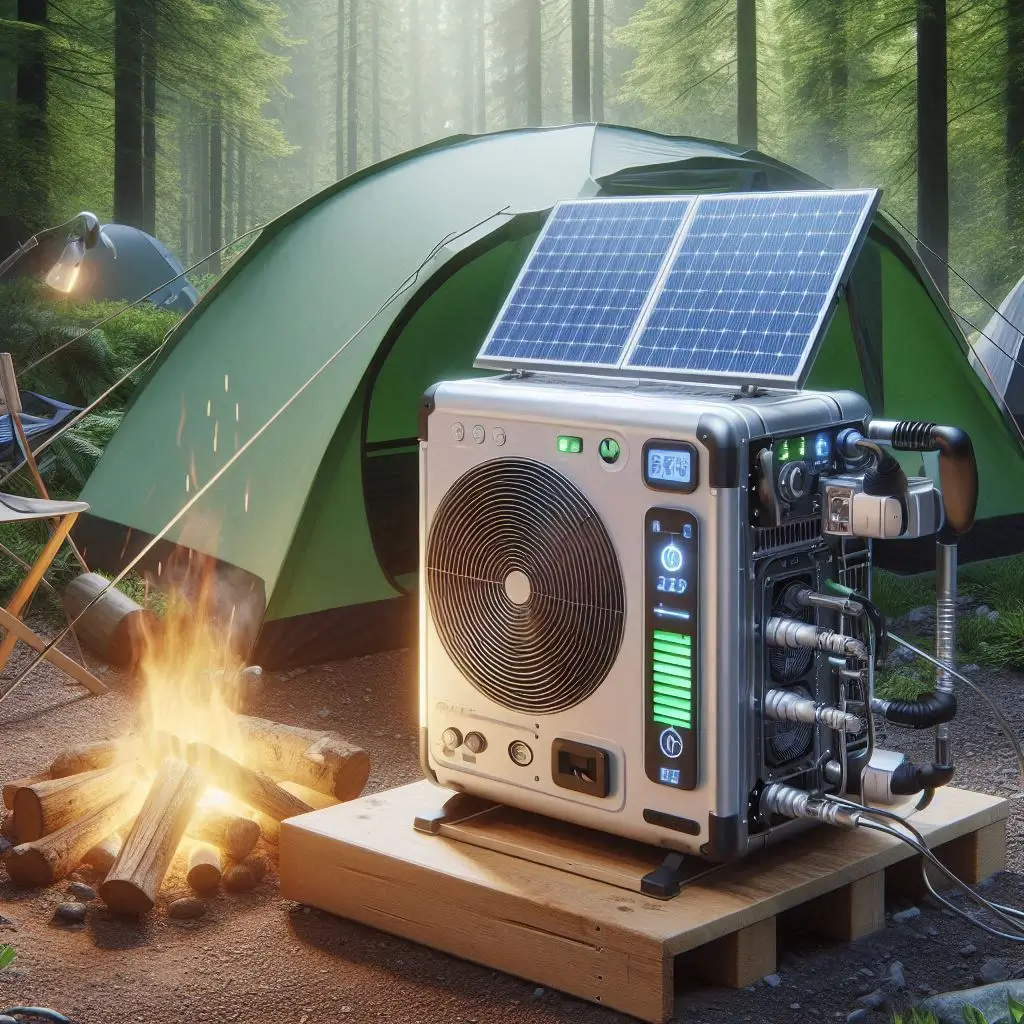
5. How do I maintain my portable air conditioner while camping?
Maintaining your portable air conditioner while camping is crucial for optimal performance. Here are a few tips:
- Clean the Air Filter: Check and clean the air filter regularly to prevent clogs that can reduce airflow and efficiency.
- Monitor Water Levels: If your unit has a water reservoir for evaporative cooling, empty and refill it as needed to ensure effective operation.
- Check Connections: Regularly inspect power connections and hoses to ensure there are no leaks or damages.
By keeping up with maintenance, you can ensure your air conditioner runs smoothly and efficiently throughout your camping trip.

Common Misconceptions About Portable Air Conditioners for Camping
When considering a portable air conditioner for camping, many potential users fall victim to common misconceptions that can cloud their judgment. Understanding the truth behind these myths can help you make an informed decision and fully enjoy the benefits of portable cooling solutions while camping.
Myth 1: Portable Air Conditioners Are Too Heavy for Camping
Many campers believe that portable air conditioners are cumbersome and difficult to transport, leading them to forego this option for outdoor cooling. However, the market offers a range of lightweight models specifically designed for camping.
-
Lightweight Options: Many portable air conditioners weigh between 2 to 5 pounds, making them easy to carry in your camping gear. These compact units are designed with portability in mind, often featuring handles or carrying cases for easy transport.
-
Convenience in Design: Some units are also designed to double as fans or evaporative coolers, providing versatile cooling solutions without adding significant weight to your gear. This makes them ideal for outdoor adventures where every ounce counts.
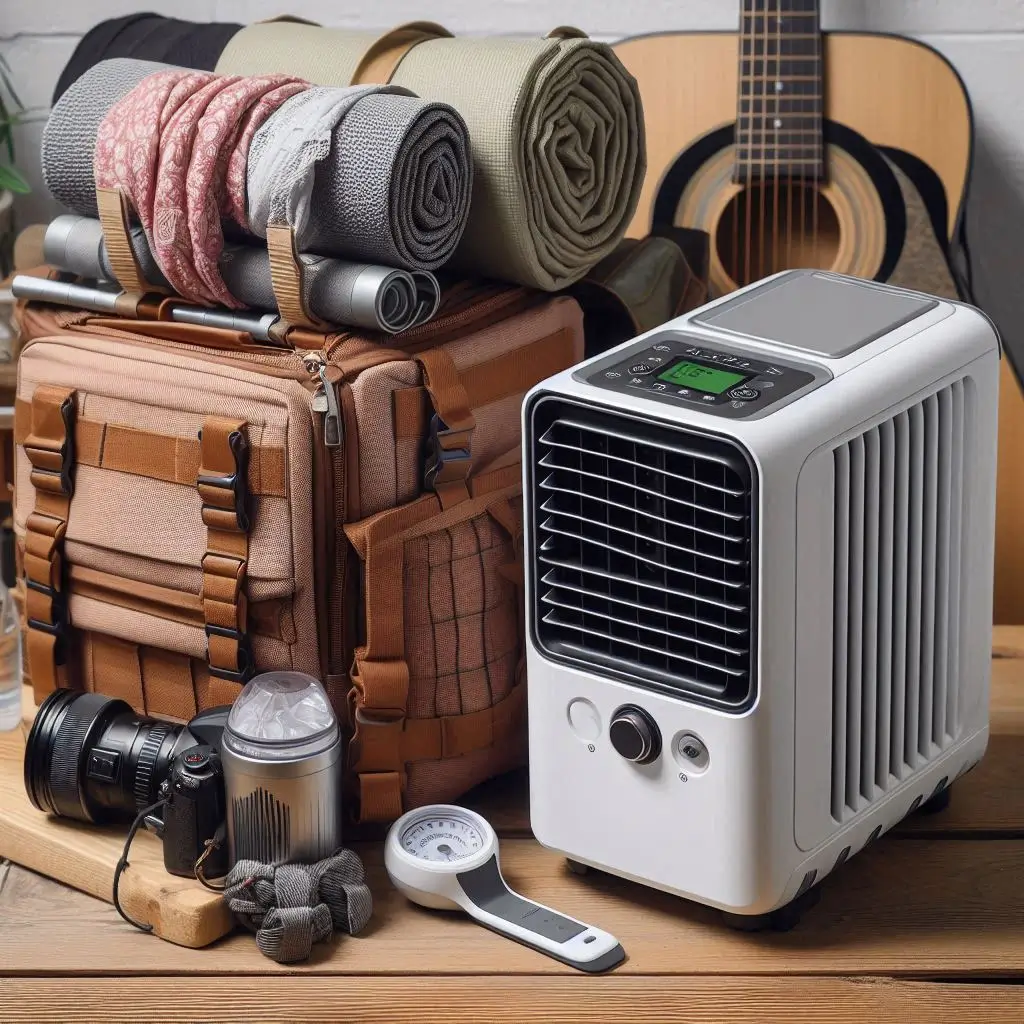
Myth 2: They Consume Too Much Power
Another common misconception is that portable air conditioners will quickly drain your battery or require extensive power resources. While larger units can consume significant energy, many modern portable air conditioners are designed with energy efficiency in mind.
-
Energy Efficiency Ratings: Look for units with high Energy Efficiency Ratio (EER) ratings, which indicate how much cooling is provided per unit of electricity consumed. These models use advanced technology to minimize power consumption while delivering effective cooling.
-
Battery-Friendly Designs: Many portable air conditioners are specifically engineered to work well with battery power or solar energy, allowing campers to enjoy cool air without being tethered to traditional power sources. This makes them suitable for off-grid camping adventures.
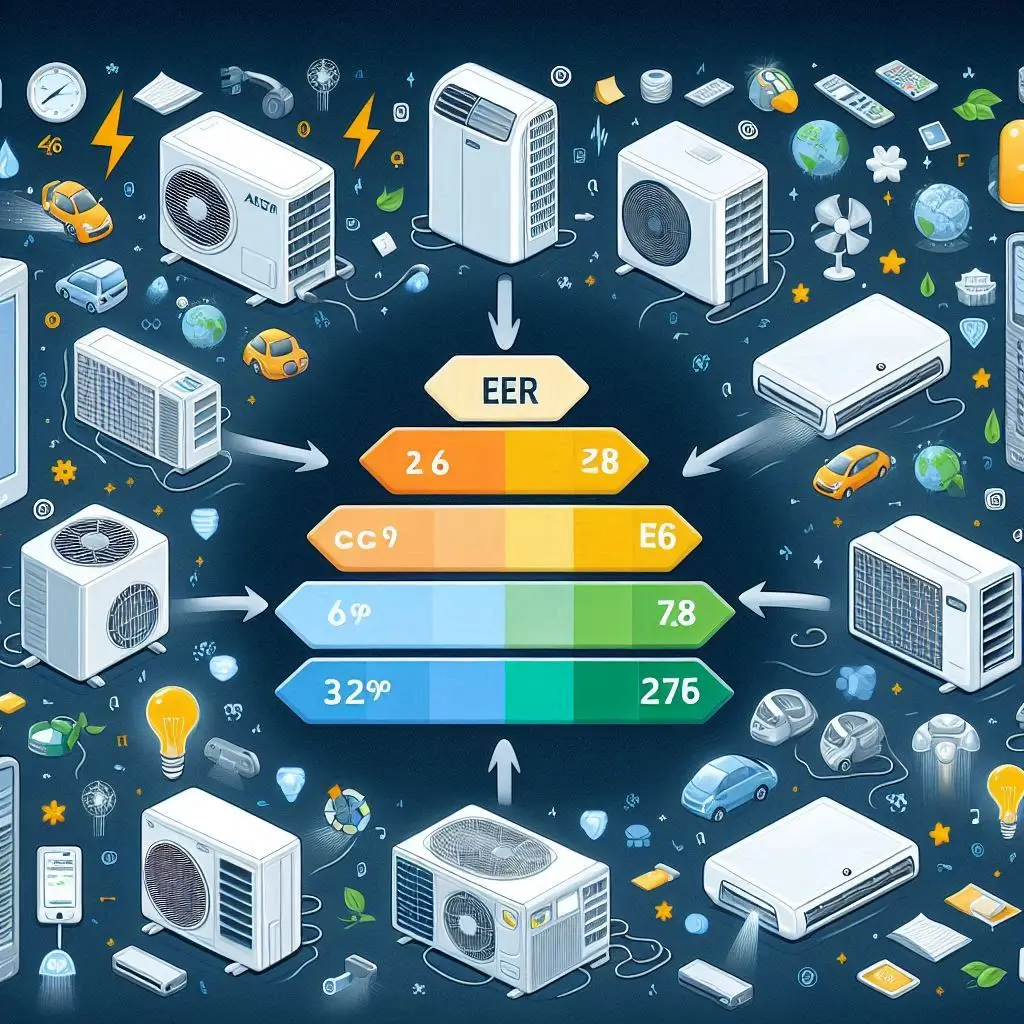
Myth 3: They Don’t Cool Effectively
Some campers worry that portable air conditioners cannot adequately cool a space, leading them to think that these units are not worth the investment. However, when appropriately sized for the area and set up correctly, these units can provide sufficient cooling even in hot outdoor conditions.
-
Sizing Matters: Understanding BTU (British Thermal Unit) ratings is crucial when selecting a portable air conditioner. A unit that is too small for your tent or RV may struggle to maintain a comfortable temperature, while an oversized unit may cool too quickly without adequate air circulation.
-
Proper Setup: Correct placement and setup are essential for effective cooling. Ensure the unit is positioned to allow for proper airflow and ventilation. Additionally, using fans in conjunction with the air conditioner can help distribute cool air more evenly throughout the space.
Eco-Friendly Alternatives to Traditional Portable Air Conditioners
As awareness of environmental sustainability grows, many campers are seeking eco-friendly alternatives to traditional portable air conditioners. These sustainable options not only reduce your carbon footprint but also provide effective cooling solutions for your outdoor adventures.
Evaporative Coolers
Evaporative coolers, commonly known as swamp coolers, are an excellent eco-friendly alternative to traditional air conditioners. They utilize the natural process of water evaporation to cool the air, resulting in energy-efficient and environmentally friendly operation.
-
How They Work: Evaporative coolers draw warm air through water-saturated pads, causing the water to evaporate and cool the air before it is circulated into the living space. This process uses significantly less electricity than conventional air conditioning.
-
Best for Low-Humidity Environments: These units are most effective in dry, low-humidity climates, making them ideal for many camping locations. Their lightweight design allows for easy transportation and setup at campsites.
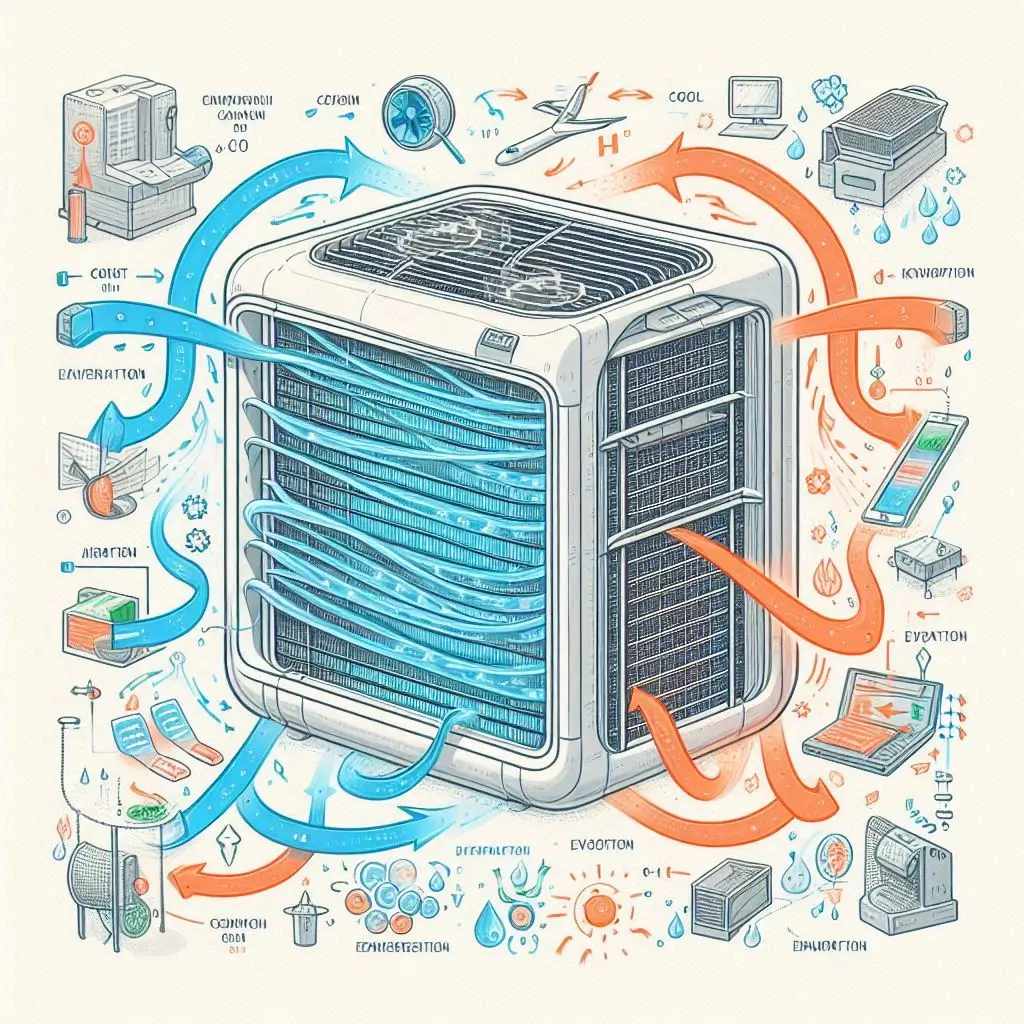
Solar-Powered Air Conditioners
For campers looking to reduce their carbon footprint further, solar-powered air conditioners provide a sustainable solution that harnesses renewable energy.
-
How They Operate: These units convert sunlight into electricity to power the air conditioning system, allowing you to enjoy cool air without relying on traditional power sources. Many models come equipped with solar panels that can be set up alongside your campsite.
-
Compact and Portable Designs: Many solar-powered air conditioners are designed to be lightweight and portable, making them ideal for off-grid camping. With advancements in technology, these units can deliver adequate cooling while being environmentally friendly.
Personal Cooling Devices
In addition to traditional air conditioning solutions, small personal cooling devices offer effective heat relief while being energy-efficient and portable.
-
Battery-Operated Fans: These fans are lightweight and easy to carry, providing a convenient way to stay cool without consuming much energy. They can be powered by batteries, making them perfect for camping trips where electricity may not be available.
-
Portable Misting Systems: Another great option is portable misting systems, which spray a fine mist of water to cool the surrounding air. These devices require minimal power and can provide quick relief from heat while being easy to transport.
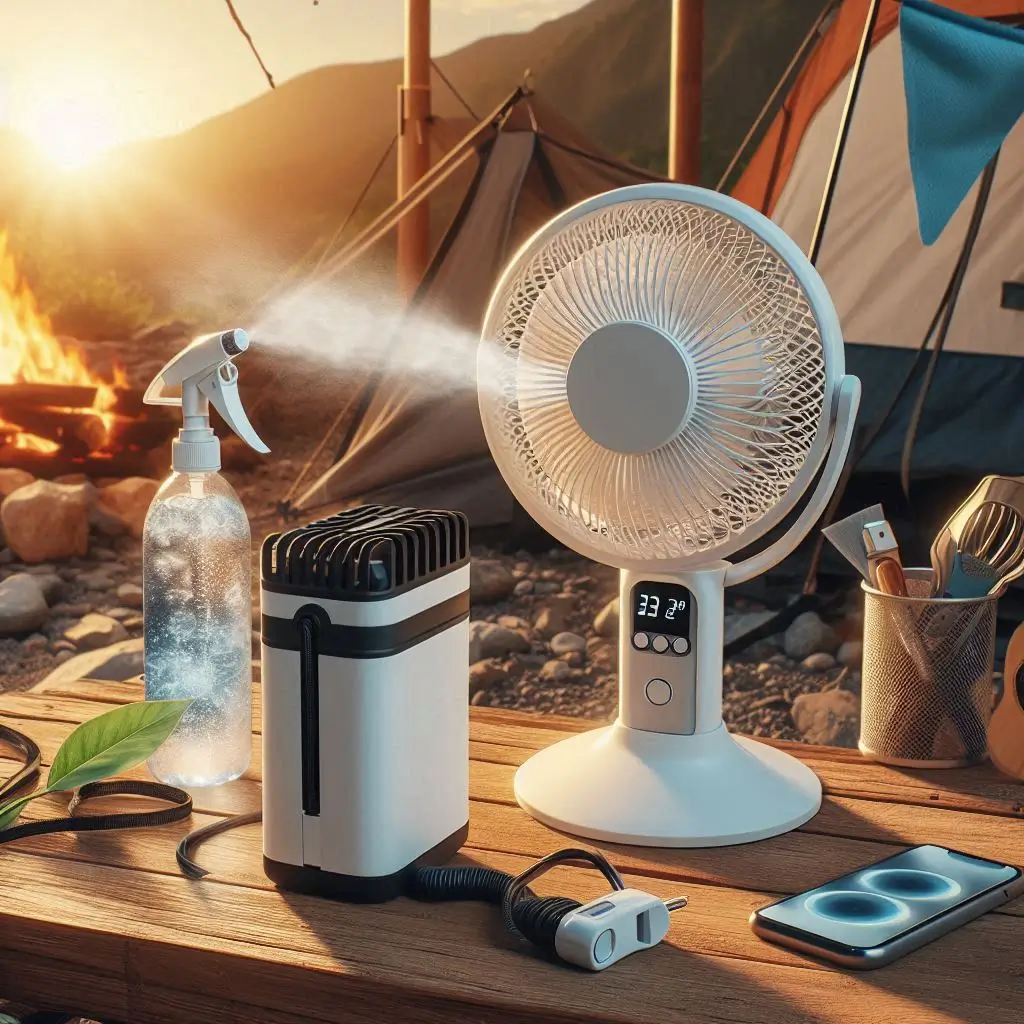
Conclusion:
In conclusion, selecting the right portable air conditioner for camping can significantly enhance your outdoor experience by providing much-needed comfort during hot weather. By understanding the various options available, including size, power sources, and cooling capacities, you can choose a unit that best fits your needs. Proper setup and maintenance are essential for optimal performance, ensuring you can enjoy cool air while embracing the beauty of nature. With the insights shared in this blog, you are now equipped to make an informed decision on the smallest portable air conditioner for camping. Stay cool and comfortable on your next adventure, and enjoy every moment of your time spent in the great outdoors.

